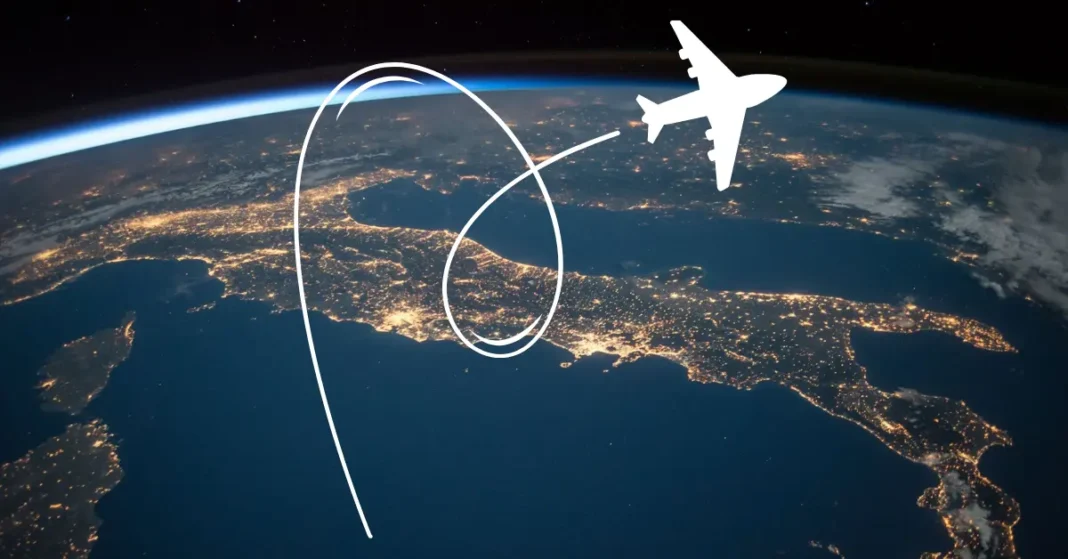Dreaming of circling the world in a plane is a fantastic idea, filled with thoughts of faraway places, different cultures, and the vast sky above. But the way you take this journey can be quite different. Some people go in fancy private jets, making stops at luxurious destinations, while others choose carefully planned trips on regular airlines with multiple stops. Each option tells a unique story of discovering the world.
Let’s explore the various ways you can fly around the world, comparing the experiences, costs, and how long it takes. This way, we can help every aspiring adventurer find the right way to fulfill their travel dreams.
Table of Contents
How long would it take to fly around the whole world?
The duration of a global circumnavigation is influenced by several factors:
- Aircraft Speed: The speed at which different aircraft travel varies. Commercial airliners generally cruise at around 900 km/h (559 mph), whereas supersonic planes can exceed 2,000 km/h (1,243 mph).
- Route: While the shortest path around the globe is along the equator, approximately 40,075 kilometers (24,901 miles) in circumference, many global flights take longer routes that deviate from this line.
- Refueling: Most aircraft lack the fuel capacity for a non-stop global journey, necessitating one or more refueling stops.
Estimated flight times for circumnavigating the world include:
- Commercial Airliner: 44-45 hours (non-stop), 50-60 hours (with refueling)
- Supersonic Aircraft: 20-25 hours (non-stop)
- Small Private Jet: 70-80 hours (with refueling)
These are rough estimates, as actual flight times depend on the specific considerations mentioned.
Noteworthy round-the-world flights include:
- Fastest Flight: Virgin Atlantic GlobalFlyer in 2005, completing the non-stop journey in 67 hours and 1 minute.
- Longest Distance: Solar Impulse 2 in 2016 covered 42,420 kilometers (26,359 miles) in 17 legs.
- First Solo Flight: Wiley Post in 1933 took 7 days, 18 hours, and 49 minutes.
Flying around the world represents a remarkable achievement in engineering and human innovation, showcasing the strides made in aviation technology and the extraordinary capabilities of modern aircraft.
Types of around-the-world flights
Imagine the Earth as a massive, inviting canvas, eager for you to splash it with your trails. In the realm of the free-spirited, travel isn’t just movement; it’s a symphony of experiences. And what’s the grand instrument in this melodious adventure? Flying, of course! But did you know there’s more than one way to conquer the skies? Buckle up, fellow globetrotters, as we explore the different ways to fly around our awe-inspiring world.
Boarding a commercial airline is the classic choice for most adventurers. Picture the array of options: from budget carriers that get you from A to B without the frills, to premium airlines where sipping champagne above the clouds is just a part of the journey. There’s a flight for every fancy and funds.
For those who prefer to master their itineraries, round-the-world (RTW) tickets offer a structured yet flexible route to span the globe. These tickets, offered by airline alliances, allow multiple stops and often have a one-year validity—just the ticket for the leisurely explorer craving a taste of continents across the maps.
But let’s not forget the unconventional wings for the unbound spirits. Embrace the ride on a chartered flight where the schedule bows to your whim, or delve into the world of air mileage programs where loyal airborne commuters can cash in miles for a ticket to their next dream destination.
Then there’s the ultimate personalized sky experience: flying private. It’s not just a myth laid out in luxury magazines; there are ways to snag a seat on a private jet without owning it—think empty-leg deals or shared private services.
Embracing these myriad modes of flying invites a world of possibilities, where each journey through the clouds is as unique as the wanderer partaking in it. Adventure, in its lofty forms, is always within reach for those eager to spread their wings and let the sky be their playground. So take flight, intrepid friends, and let the winds of whim dictate your next horizon!
Record-breaking flights and typical durations
If you’ve ever dreamt of circling the globe, know that the speed of your journey hinges on the routes taken and the layovers in between. Travelers curious about the fastest circumnavigation should look towards commercial flights – specifically those aided by round-the-world (RTW) programs – as they can whisk you around the world in approximately a week, depending on connection times and flight availability. On the flip side, forging your path could take upwards of a month, offering a blend of ambling exploration and swift air travel.
For the speed-seekers, the current record for the fastest flight around the world was set by a purposeful mission that did it in a bit under 42 hours, but that’s not your typical commercial ticket experience! Normally, even with the swiftest layovers and ideal routes, one could realistically expect such a global jaunt to span from a minimum of three days to a week, allowing for decent rest and the unavoidable jugg of international timetables.
Ultimately, the time frame of a round-the-world adventure is less about racing against the clock and more about immersing oneself in the journey. Whether you prefer the swiftness of direct routes or the leisure of extended stopovers, the open sky crafts a canvas for your own unique travel story, punctuated by each takeoff and landing that contours your global route. Embrace the skies and let the possibilities of worldwide flight elevate the wanderlust within you.
Maximizing your around-the-world flight experience
Embarking on an around-the-world journey is not just about the flights—it’s about the vibrant tapestry of experiences one can weave together. This priceless fabric can be enriched by strategically choosing accommodations that double as cultural immersions. Swap out the conventional hotel room for a local homestay, a rustic mountainside chalet, or even a hammock under the stars.
Each stay becomes a chapter in the traveler’s ongoing epic, flavored with the local zest of community life, homemade cuisines, and the inside scoop on hidden gems that can’t be found in any travel guide.
Moreover, the true globetrotter knows the value of flexibility in their itineraries. Diving into the ebb and flow of local events can turn a simple stopover into an unforgettable adventure. Be it a spontaneous festival that engulfs a city in celebration or a local market that offers an authentic taste of the region, embracing the serendipitous has a charm all its own.
Craft your journey not just with destinations, but with experiences—bookmarking every free walking tour, cooking class, and nature hike that tickles your fancy. Remember, memories aren’t just made by the sceneries; they’re crafted through interactions, taste, laughter—and perhaps even the occasional misadventure.
And when the wanderlust coaxes you to venture beyond the comfort of the beaten path, remember: transportation is just as much a cultural immersion as the landmark you’re headed to. The rickety ride on an age-old train, the breeze in your hair from the back of a motorbike, or the camaraderie found on a long-distance bus are not mere transitions from point A to B but are threads of the local fabric that you’re there to experience.
With a mosaic of travel methods, the journey unfolds like a novel, each page a passage to a new horizon. Mingle with locals on ferries, share stories on cross-country railroads, and let the world unveil itself at the pace of its people—not just its airlines.
The desire to soar across the heavens, stitching the tapestry of the Earth’s landscapes beneath one’s wings, is a timeless human aspiration. With a touch of strategic planning and a dash of adventurous spirit, an around-the-world flight transforms from a distant dream into a series of unforgettable memories.
As we glide back to our starting point, we carry with us not just souvenirs and snapshots, but a deeper appreciation of the planet we share and the endless skies that bridge our horizons. The world awaits those daring enough to take flight and embrace its circle, revealing that the truest journey is not just found in the destination, but in the voyage itself.
What is the fastest flight around the world?
The record for the quickest journey around the world is held by the Virgin Atlantic GlobalFlyer. In 2005, pilot Steve Fossett completed the non-stop flight in an astonishing 67 hours and 1 minute. During this remarkable journey, the aircraft maintained an average speed of 590.2 km/h (366.7 mph) and covered a total distance of 37,785.4 kilometers (23,478.5 miles).
Can a plane fly around the world without stopping?
In theory, a plane can fly around the world without stopping. However, only a limited number of aircraft possess the necessary range and capability to achieve this feat.
Can you fly around the world in 24 hours?
No, flying around the world in 24 hours with current technology is not feasible. The Earth’s equatorial circumference is about 40,075 kilometers (24,901 miles), requiring an average speed of approximately 1,670 kilometers per hour (1,037 mph) for such a journey.
Existing aircraft, including supersonic jets like the Concorde, cannot attain the needed speed. Even if a plane could, it would face challenges due to fuel limitations, needing an impractical amount of fuel to cover the entire distance without refueling, impacting both the aircraft’s weight and range.
Practical considerations also play a role in making a 24-hour circumnavigation implausible. These include logistical challenges and the need for multiple refueling stops. These limitations highlight the technological and practical constraints on achieving such a swift global journey with current aviation capabilities.





